Tech debt: How to Manage Debts for your Software Development?
What pains you more, debt or interest compounding on your debt? An IT team can’t afford either of these for its software. Most of these debts occur when teams rush their software development. However, rushing app development is not the only cause of tech debt.
For example, the Stack Overflow careers login page needed an update with the design. However, due to technical debt, redesigning the page was difficult. There were two separate apps for the login page working together. One was StackOverflow careers login, and the other was CareersAuth.
In its initial days, StackOverflow did not want to rely on an external OpenID provider to verify a user’s identity. So, they built an in-house OpenID app called CareersAuth. However, it did have a caveat that whenever a user created an account or changed the password on the StackOverflow careers page, it wasn’t saved on CareersAuth due to split architecture.
The best approach was to get rid of CareersAuth and reframe the architecture. So, they decommissioned the CareersAuth to reduce tech debt. However, identifying the tech debt’s causes and devising a plan is essential. So here is a comprehensive guide on tech debt!
What is Technical debt?
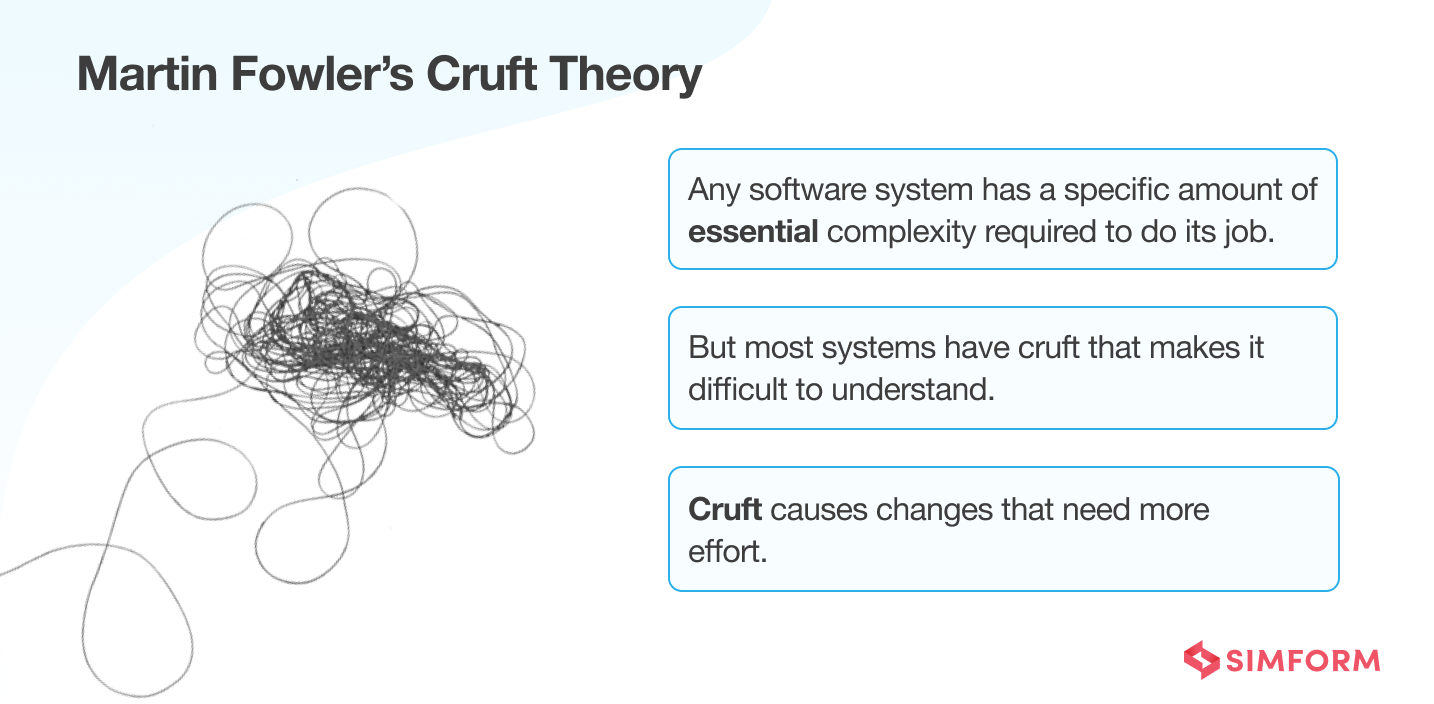
Technical debt results from trade-offs made during software development that prioritize short-term gains or deadlines over long-term maintainability and quality.
It represents the compromises made in a software system’s codebase, architecture, design, documentation, or other technical aspects. It is similar to financial debt, as it involves making trade-offs in the present that may have long-term consequences.
A metaphor coined by Ward Cunnigham – Technical debt – is a “cruft,” according to Martin Fowler. Cruft describes program elements, system, or product which is either useless or poorly designed, damaging the ROI.
Every software development process involves several complex tasks. But, when these complex tasks become cruft, they take more time, effort, and resources to make essential changes, resulting in inefficient processes.
Top 5 causes of tech debt
Technical debt will likely arise when organizations make design decisions based on the deadline rather than performance. The compulsion to expedite the development process leads to changes in the future, ultimately costing way more than what was invested initially.
However, indiscreet acceleration of the development process is not the only reason that can cause tech debt. Here are the common reasons for tech debt.
1) Budget constraints
Organizations are looking to reduce costs and expedite development to ensure better ROI. However, what transpires is quite the opposite. Initially, you may go linear in the approach and use minimal resources, technologies, and development time, but later, it costs even more to make the changes.
Research also shows that refactoring costs correlate significantly with architecture smells (design decisions that negatively impact flexibility, testability, and reusability).
2) Technology evolution
Constantly evolving technologies have reshaped the way modern business functions. Take an example of the containerization approach. Earlier virtual machines or VMs were an excellent option for virtualizing resources.
However, with containerization gaining traction, many organizations using VMs started considering or migrating to containers. And the selection of VMs vs. containers requires careful consideration.
Unlike VMs, some technologies become redundant, increasing the tech debt for organizations. For example, an advisory by the US government recommended the use of TLS(Transport Layer Security) protocols like TLS 1.2 and TLS1.3.
So, companies with older versions like SSL 2.0, SSL3.0, TLS 1.0, and TLS 1.1 had to manage a tech debt of obsolete security protocols enforced through digital certificates.
3) Skill gap and developer shortage
Newer work models and technologies have induced a skill conundrum in the market. And so, companies are struggling to find a workforce with the right skill sets to bridge the gap between user requirements and technical assistance. Korn Ferry report suggests an $8.5 trillion skill shortage by 2030.
So, how to ensure that the skill gap does not add to your organization’s rising tech debt? First, you need a skill-based analysis of the project to forecast the need for developers or skilled professionals in the future.
As it is not always an easy task with constant technological innovation, the best option is to hire dedicated development teams. Companies that provide dedicated teams have a pool of talents with multiple skills reducing your tech debt due to skill gaps.
4) Lack of quality testing
Testing your software is essential. However, many organizations cut corners in terms of testing for two reasons,
- Need for faster time to market
- Lack of QA support
The desire for speed and the absence of a streamlined process often compromises software quality and ultimately lead to tech debt.
Leveraging DevOps culture is the best way to ensure such tech debt does not affect your software development. It also helps improve collaboration between the development and operations teams for a streamlined process. Further, building a CI/CD pipeline with DevOps ensures that you have enhanced software development and testing.
5) Insufficient documentation
Documentation of development, testing, deployment, and maintenance phases is key to your business. However, many organizations lack comprehensive documentation, which leads to tech debt.
The best way to ensure proper documentation is to use automation through a DevOps culture. For example, you can automate documentation in the development workflows to ensure that each stage is documented for future reference of developers.
Martin Fowler’s debt quadrant: Reckless/prudent vs. Deliberate/inadvertent
Martin Fowler’s debt quadrant on tech debt is based on four key terms,
- Reckless
- Prudent
- Deliberate
- Inadvertent
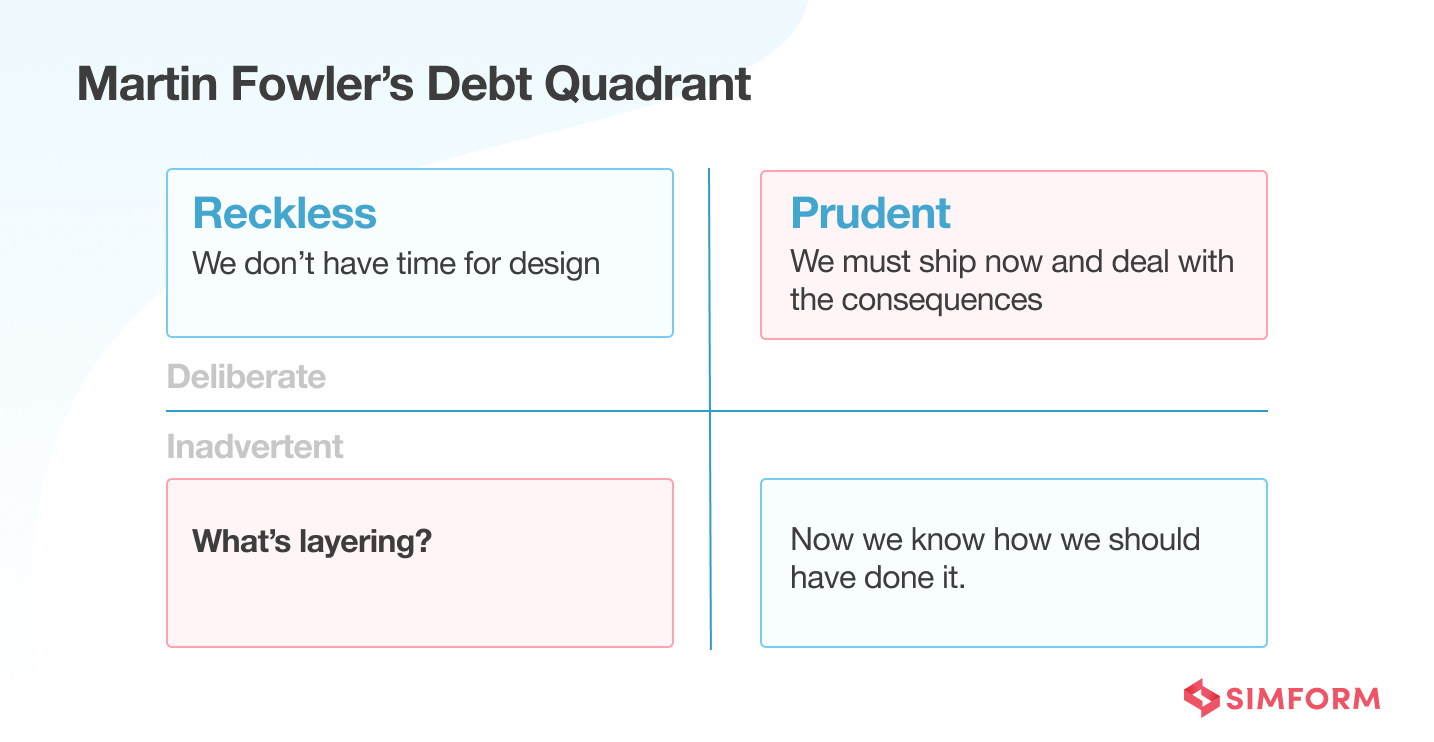
In his article on technical debt, Martin Fowler discusses four types of debt, each of which acts as a metaphor. However, understanding the metaphor is key to reducing tech debt. The debt quadrant categorizes four types of debts based on intent and context.
Deliberate and reckless debts
Such types of debts occur when specific decisions can result in tech debt, yet organizations decide to move forward. Here, organizations prioritize speed over quality. Most startups prioritize time to market over quality.
The reason is simple; startups may want to ship their MVP to raise funds or get proof of concept for their idea. However, despite the intention being right, the ultimate result is unavoidable technical debt.
Deliberate and prudent
Deliberate and prudent tech debt is where organizations know that prioritizing speed can lead to technical debts, but they choose to go with it. However, here, businesses first analyze all the consequences and then create an efficient plan of action to minimize the risks. So, if releasing early provides a bigger payoff, companies choose deliberate and prudent tech debt.
Inadvertent and reckless
This is one of the most dangerous tech debts where teams may implement a solution without enough knowledge. For example, an organization lacks skilled professionals and has inexperienced developers to implement software development. Due to a lack of skills, knowledge, and experience, software development leads to technical debt.
Inadvertent and prudent
Inadvertent and prudent debt is where developers are knowledgeable and apply the best practices in software development but inadvertently cause tech debt. Such tech debt has to do with evolving technologies and practices. Teams can rectify all the coding mistakes later through learning and innovation to pay off the tech debt.
However, there are ways to reduce it- “But How?”
First, you need to know the problem to find a solution, and here are the types of tech debt.
Types of tech debt
As discussed, technical debt has four types, prudent, reckless, deliberate, and inadvertent. However, you need a deeper analysis to implement best practices.
Maintenance debt
Long-term debt can also be termed maintenance debt, which results from several inefficiencies accumulated over a long period.
Maintenance debt generally occurs when organizations delay the changes, leading to an inflection point where adding new features becomes difficult. Here are some scenarios of long-term debts,
- Obsolescence is when it’s difficult for organizations to find newer versions of specific third-party software or services.
- Incidental complexity is when a design complexity is introduced without knowledge or intention.
- Software entropy is the unpaid technical debt that occurs due to the aggregation of several deliberate and reckless debts.
Developer efficiency debt
Developers’ efficiency and productivity go for a toss when most of the time is spent maintaining the systems and reducing tech debt. According to a report, developers spend more than 17.3 hours weekly on debugging, refactoring, reducing technical debt, and software maintenance jobs.
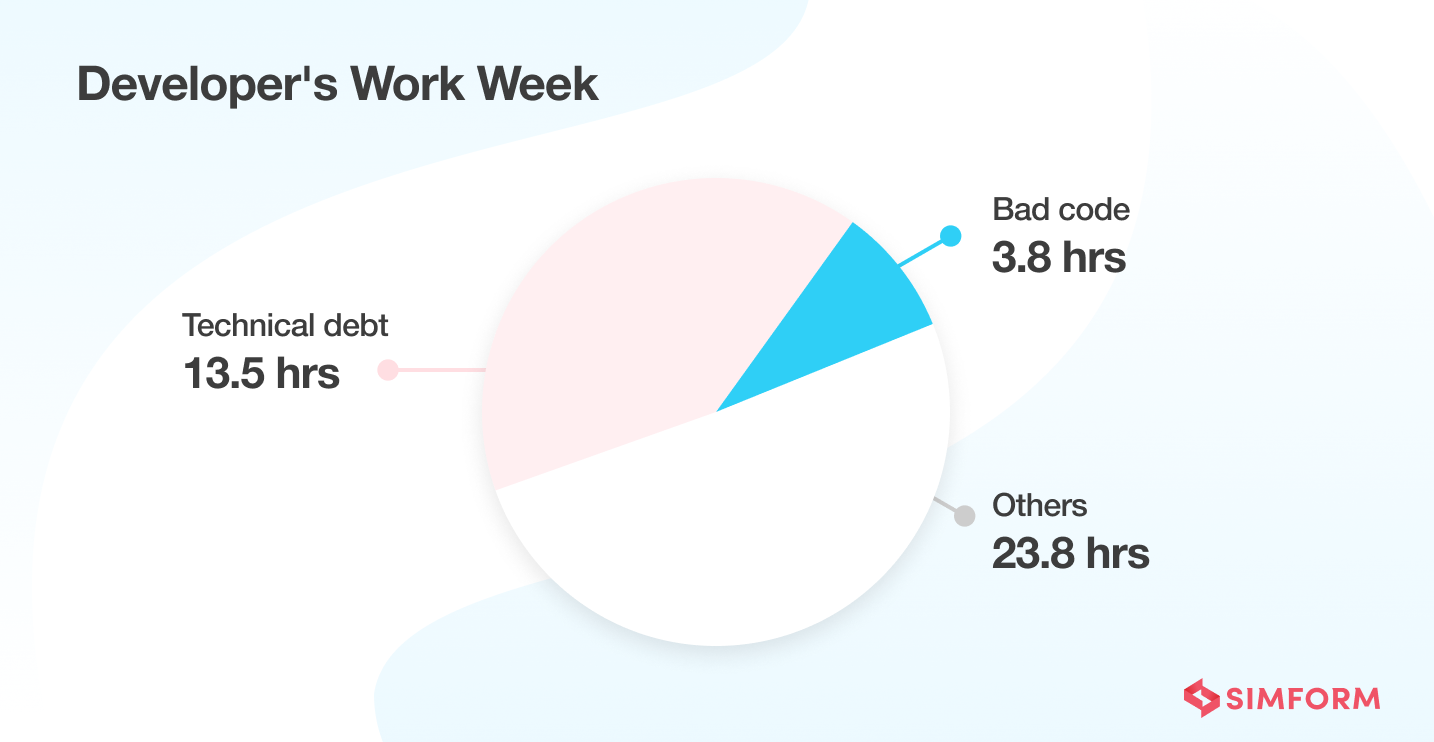
So, reducing time spent on technical debts is essential to allow developers to focus on innovations.
Stability debt
Software stability is key to enhanced user experience. However, technical debt can lead to disruptions in software stability. Here, measuring the software stability and impact of technical debt is essential.
So, how do we measure stability?
You can use stability scores to measure software stability. Application stability has several factors which you need to consider like,
- Availability
- The period between the two crashes
- Feature responsiveness
Tech debt can affect your application stability due to obsolete third-party services, rushed code building, or a lack of testing strategy. According to Bugsnag, 84% of users abandon apps after two crashes. So, there is no denying that you need stable apps for higher conversions. This is why it is essential to reduce tech debt which causes stability issues.
Security debt
Software security allows organizations to protect their digital assets and services from being disrupted or exposed to cyberattacks. However, organizations with rushed development processes often ignore the security part.
Security debt can hinder developers’ productivity and burden the IT teams long term. Take the example of Equifax. The credit reporting company faced a data breach due to a lack of security patches in Apache Struts, a popular web app framework.
The security patch was available for months, but implementation was delayed, leading to 147 million people being affected. So, companies must implement appropriate security patches to avoid cyber attacks and reduce technical debt.
Decision debt
There are many different types of decision debts. For example, when an organization makes a particular decision in the present, which affects the future adversely, it becomes a bad debt. Another decision debt is when an actionable event is untended. Issues are naturally aggravated when the required action is not taken.
Among all the types of debts, decision debt is the most significant as it impacts all technical debts.
How To Manage Technical Debt?
We know various reasons for technical debt contributing to disruptions, lower productivity, increased costs, etc. However, you can reduce these debts with some best practices, which include tracking debts, monitoring and identifying them, refactoring architecture, and improving software stability.
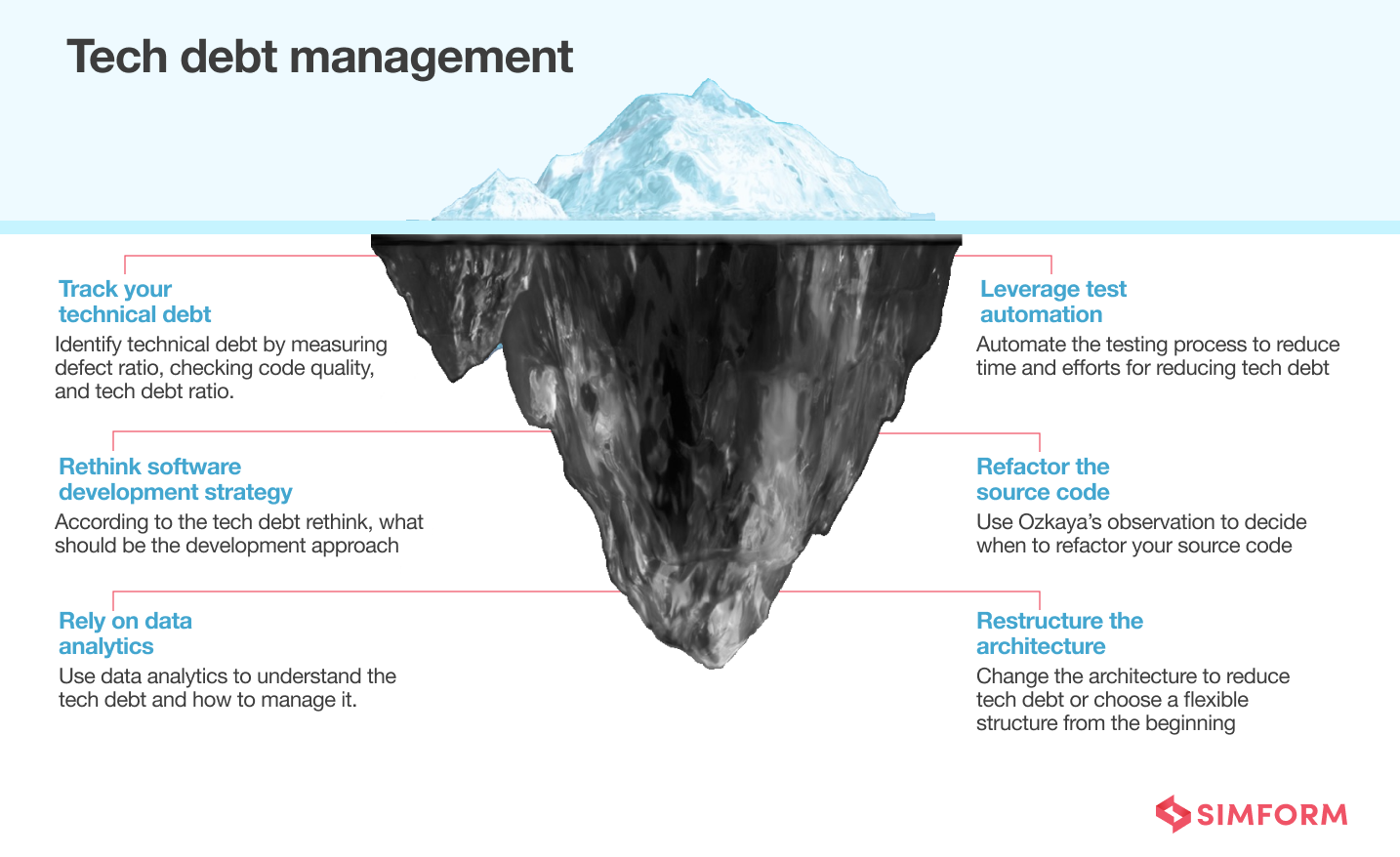
Track your tech debt
Tasks are often delayed or kept on hold for various reasons like lack of skilled professionals, technology, and resources. And when aggregated over time, these tasks cause disruption.
Here are some metrics you should measure to track tech debts –
Defect ratio
A software development team can assess defects through the ratio of old and new ones. When new defects are insignificant and fixed defects have a higher number, the ratio would be smaller.
Consequently, if new defects outnumber the fixed flaws, the overall defect ratio will be higher, showing how technical debts are increasing.
- Code quality
Quantifying the code complexity and quality is key to understanding the technical debts. You can use the following metrics to measure code complexity, - Cyclomatic complexity helps measure the number of linear paths each node will take in your code.
- Lines of code is a straight-up metric that allows measurement of the total lines of a source code.
- Coupling is a metric to measure a function’s dependency on other elements in your codebase.
- Maintainability index helps measure how easy your code is to maintain
Cognitive complexity helps measure how much cognitive effort it will take to understand the code flow.
Technical Debt Ratio
If you want to calculate the cost of technical debt occurring in future years, the technical debt ratio(TDR) helps. You can compare the costs of fixing problems against the project’s total cost. Higher ratios mean more technical debt.
Rethink the software development strategy
A software development approach has to be specific to the requirements of the individual organizations. The best way to integrate best practices with your software development approach is to find a middle ground between expectations and outcomes.

So, when your manager wonders about the delays in getting releases ready for deployment, a middle ground may be missing, which helps improve your builds gradually with agile development.
The debate of waterfall vs. agile continues amidst widespread acceptance of agile practices. The iterative method makes agile a promising approach to reducing technical debts. You have small iterations, with each one of them integrating the feedback from earlier versions.
So, the aggregation of technical debts is reduced, allowing for improvement with each iteration.
Rely on data analytics
Data-driven decision-making is the best practice for reducing technical debts any day. However, the biggest question that most organizations face is which data to follow.
- Record, analyze, and maintain software performance data
- Log each flaw, fix, and bug of the software
- Document all the security breaches and code issues
- Calculate the cost of each fix
- Gather data on each disruption in the operation.
Analyze all the data gathered and be better prepared to reduce technical debt for your software development projects.
Leverage automated testing
One of the significant challenges for an organization on a timeline is managing the release’s quality. The testing phase needs a dedicated strategy, resources, and time.
Automation can help you reduce testing time and resources allowing teams to focus on the quality within the deadline. So, testing automation can reduce errors and technical debts.
Here are some of the key benefits of automation for testing tech debt,
- It helps in reducing costs.
- Enables rapid testing
- Requires less developer focus
- Improves productivity
- Reduces chances of post-release fixes
Refactor the source code
Refactoring the source code is a big decision for any organization. However, it helps in reducing technical debt. So, at what point can you consider refactoring the code?
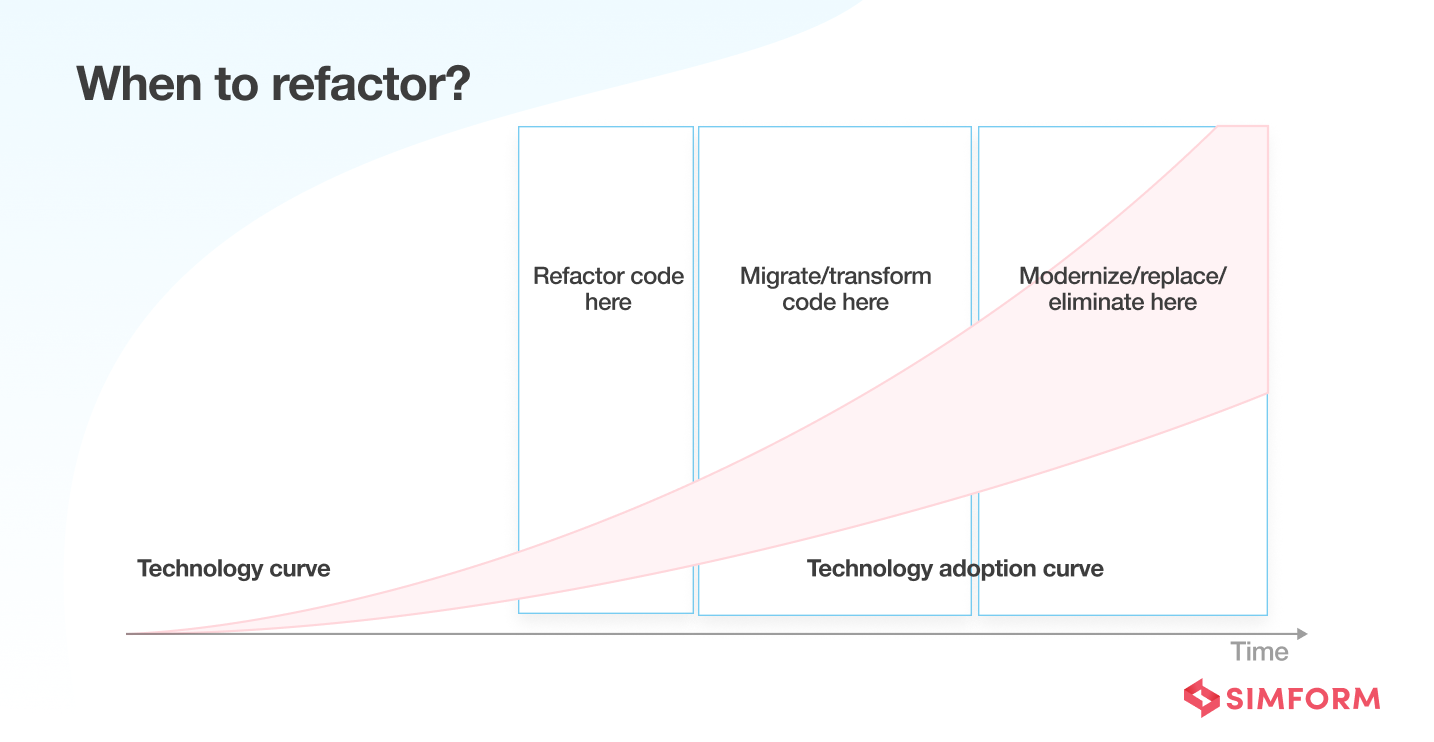
According to the book “Managing Technical Debt — Reducing Friction in Software Development,”; there are three stages of managing debt,
- Inaction- When no action is required due to insignificant debt
- Replace-It is a long and expensive approach to replacing the entire system due to legacy issues
- Refactor- Here, according to Ozkaya, refactoring needs to be gradual. Invest and pay attention to each sprint for incremental improvements in the code quality.
So, if you decide to refactor your code in a gradual approach, it may take more time, but the result will be better. Especially when you want to keep up with the new evolving technologies, agile practices are the best choice. Furthermore, re-architecture is essential to reduce technical debt if you consider replacing the system.
Restructure the architecture
Restructuring the software architecture according to current technologies and capabilities is another way to reduce technical debt. Take the example of building an analytics platform for, Larvol a pharmaceutical companies.
The pharma-based company sought a solution to provide real-time data analytics by curating millions of tweet data. A flexible architecture was a natural choice to curate all the data, analyze, and convert information into the desired state.
Microservices architecture was chosen as it provided a decoupled structure. It offered independent services connected through APIs.
Unfortunately, businesses look to put their ideas on the market quickly and rush software development, making the architecture-building process hasty. A lack of proper software architecture leads to technical debt, which companies pay through restructuring.
So, it becomes crucial to create a flexible architecture for your software or restructure it if there is too much tech debt.
What is technical debt in agile?
Agile development practices allow organizations to develop software in small increments. Each iteration is short and uses a linear approach to development. However, emphasis on speed may often compromise the quality, leading to technical debt.
Many teams work simultaneously on different tasks and functions for an iteration. So, technical debt will be unavoidable if agile teams do not own their mistakes or shortcuts to meet deadlines.
Besides the ownership of errors, delays in code approvals can also lead to technical debt in an agile development process.
Here are four practices that can help you reduce tech debt in agile,
- Test-driven development(TDD) is a practice where developers use the “test-first” approach. In other words, you write the test first for failure and program your feature to conform accordingly.
- Mob programming is placing all the developers and scrum masters together at the same place for all the tasks. Here code is reviewed in real-time as it is written, reducing the back-and-forth activities of approval.
- CI/CD ensures that all the feedback from each scrum is integrated into the next iteration with continuous delivery to end users. So, there are no delays in delivery, and code errors are refactored with each iteration.
- DevOps ensures that the development and operations teams sync for each iteration. As a result, organizations can ensure efficiency and productivity, reducing the developer’s technical debt.
What is technical debt in DevOps?
Reducing tech debt is difficult without effective collaboration between operations and development teams. DevOps helps improve communication between teams and improve collaborations. Embracing the DevOps culture and implementing CI/CD practices enables organizations to manage technical debts efficiently.
Some of the key benefits of DevOps in reducing tech debt are:
- Helps in the quicker discovery of technical debt
- Provides collaborative process of analyzing tech debt
- Improves technical debt review process
- Enables organizations to schedule maintenance
- Allows organizations to detect tech debt early and act promptly
How to implement DevOps and reduce tech debt?
Prioritizing technical debt is crucial to effectively managing it and minimizing its impact on business outcomes. DevOps practices and tools can help prioritize and address technical debt effectively.
Tools like SonarQube and Kiuwan can assist in identifying legacy code and assessing the level of technical debt.
Here is how you can embrace the DevOps culture and reduce tech debt:
- Create a categorized list of problems within the system, ranking them from high to low priority.
- Make sure your backlog has technical debt reviews documented.
- Schedule regular maintenance sprints which deal with technical debts on a priority.
- Employ CI/CD pipeline to ensure quicker tech debt identification and resolution
- Deploy a version review system to detect technical debt for each release.
How does Simform reduce your tech debt?
Whether you refactor or replace your present systems, the decision must be based on data. Gathering the information on tech debt is just the first step, as you’ll then need engineering excellence to analyze data, formulate a strategy and reduce tech debt.
The best way to ensure tech debt reduction is to track, record, analyze and refactor your code if needed. However, when refactoring and replacing your systems requires expertise, this is where Simform helps you with,
- Data analysis and tracking
- Agile implementation
- Operational excellence with microservices architecture
- Enhanced software engineering
- Complete tech debt consulting.
So, if you want to reduce technical debt, sign-up for a 30-minute complimentary session with our consultants for a complete engineering solution.






